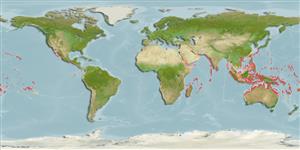Common names from other countries
Environment: milieu / climate zone / depth range / distribution range
นิเวศวิทยา
เกี่ยวกับทะเล,น้ำเค็ม เกี่ยวกับหินโสโครก; ระดับความลึก 0 - 20 m (Ref. 9770). Tropical; 30°N - 32°S
Indo-Pacific: Red Sea south to East Africa through Indonesia and northern Australia up to Hawaii and Pitcairn islands; north to southern Japan.
ขนาด / น้ำหนัก / Age
Maturity: Lm ? range ? - ? cm
Max length : 30.0 cm TL เพศผู้/กระเทย; (Ref. 30573)
เงี่ยงครีบหลัง (รวม) : 3; ก้านครีบอ่อนที่หาง (รวม) : 22 - 25; เงี่ยงครีบก้น: 0; ก้านครีบอ่อนที่ก้น: 20 - 22. Body orange-brown above; head and belly white; soft dorsal, anal and pectoral fins pale; caudal fin dusky (Ref. 4420).
Occur in shallow outer reefs subject to surge (Ref. 9770, 48637). Commonly found over barren rock or the spur-and-groove zone where there is a mixture of bare rock, rubble, and coral. Juveniles on algae reef (Ref. 48637). Benthopelagic (Ref. 58302). Feed on algae, detritus, mollusks, crustaceans, worms, echinoderms, fishes, sponges, foraminiferans, and eggs. Territorial. Oviparous (Ref. 205). Also taken by drive-in nets (Ref. 9770). Minimum depth reported taken from Ref. 128797.
Life cycle and mating behavior
Maturities | การสืบพันธุ์ | Spawnings | Egg(s) | Fecundities | ตัวอ่อน
Distinct pairing (Ref. 205).
Matsuura, K., 2001. Balistidae. Triggerfishes. p. 3911-3928. In K.E. Carpenter and V. Niem (eds.) FAO species identification guide for fishery purposes. The living marine resources of the Western Central Pacific. Vol. 6. Bony fishes part 4 (Labridae to Latimeriidae), estuarine crocodiles. FAO, Rome. (Ref. 9770)
IUCN Red List Status (Ref. 130435)
CITES (Ref. 128078)
Not Evaluated
Threat to humans
Harmless
Human uses
Warning: mysqli::__construct(): (HY000/1040): Too many connections in /var/www/html/includes/func_getlabel.php on line 46
Can't connect to MySQL database (fbapp). Errorcode: Too many connections
